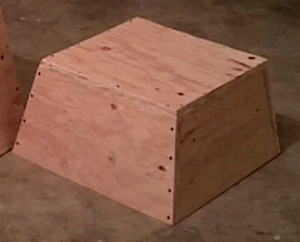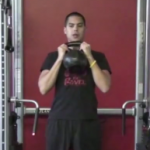 The squat is a go-to exercise for combatting too many hours in the office, but too often this is an intimidating exercise to learn. Enter the box squat – this movement is ideal for training the proper form with a little piece of mind using your DIY plyobox.
The squat is a go-to exercise for combatting too many hours in the office, but too often this is an intimidating exercise to learn. Enter the box squat – this movement is ideal for training the proper form with a little piece of mind using your DIY plyobox.
Box Squat Overview
The box squat could be explained as a full-squat with a box positioned to sit on when you reach the lowest position of the movement. For most people a 12″ tall box will work perfectly. The box serves as a gauge to ensure that you do the full range of motion. YouTube and your local commercial gym is filled with people doing lame variations of a squat where they barely complete 1/4 of the full range of motion that should exist in a full squat.
The box squat is your entry into the world of full squat perfection. Here is a brief video of Eric Cressey of Cressey Performance demonstrating the box squat.
How NOT to Squat
I just had to pull some videos on how NOT to perform the squat. Watch a few of these videos. Watch for these aspects of form so you know how to recognize when you, or anyone else, is properly performing a full squat.
Don’t Squat Like This – Go Lower
Watch how shallow these squats go. These could hardly be called 1/4 squats. This is one of the primary reasons to learn the box squat – get low.
How Not to Squat – Use the Hips, not the Knees
This one is actually a tutorial demonstrating how the squats look if you start using your knees instead of the hips. Remember the box squat will help train this properly – think sit back.
Squats Shouldn’t Kill Your Neck
When doing squats with a bar on back a tight upper torso and shoulders will force the bar too far forward and up higher onto the neck. Here’s a video that shows the problem and gives some stretches to help.
Why Learn the Box Squat
Sitting all day can kill you – fight back. By learning how to perform the full squat you will be counteracting many of the problems brought on by life in a cube: low back pain, anterior knee pain, hip pain, hamstring strains, and groin strains. Squat and get your joints moving. To perform this well you will need mobility in your ankles, hips, waist, and torso — all areas that are too often stuck sitting stagnant all day long at work in that dreaded office chair.
Box Squat Mobility
The box squat will test your mobility in your ankles, hips, and torso. Often too many hours of sitting have destroyed our mobility and subsequently our range of motion when attempting to squat. I found this great mobility progression from Tony Gentlicore to help.
Tony wrote a three part series on the Box Squat and included this progression on improving mobility.
Tony includes full video explanations of each exercise. It is worth reading – go check it out.
Box Squat Movement
To perform the box squat follow these steps:
- Lose the heals – ditch the running shoes. Pull out the Chuck Taylors, or the
VibramsGorilla Gloves, to get your feet flat on the ground. Even go barefoot if you can. - Bend the bar – if you are doing back squats pull hard with your lats. This will help lower the bar and tense the torso into position.
- Arch-baby-arch – arch your lower back and keep it that way through the entire movement.
- Think Duck-Feet – think of keeping your feet angled outward 10-15 degrees, like a duck.
- Start with your feet shoulder-width, or wider, and backed up to the corner of your 12″ plyobox.
- Push your hips back to initiate the move.
- Lower yourself back and down. Your shins should stay nearly vertical.
- Knees Out – as you lower yourself down think of pressing your knees outward. This knee-flair will help open up your hips and increase the range of motion.
- Down Slow – Slowly lower yourself until you touch the box.
- Rest, or not – Trainers differ on what is best when training the box squat. Some recommend resting at the bottom, while others suggest only gently touching to ensure that you reach the proper depth. I would start with slow controlled movements with a rest at the bottom.
- It’s in the Heels – think about your heels. You ditched the running shoes to get your heels close to the floor. Concentrate on driving all of your force down through your heels.
- Explode upward – do not rock forward. The movement should be up not forward.
- Hips fully extended – drive up until the legs and hips are fully extended.
- Glutes – buns of steel. When fully extended your glutes should be tenses as well.
- repeat
Box Squat Tutorial
Take a look at this video from Bret Contreras and his article on the different types of squats:
Is Box Squat better than other types of Squats
Better is such a subjective word. Is the box squat better at activating muscles than other forms of squatting – not really. Researchers compared the regular squat to the box squat and found there is very little differences between the two.
But I will suggest that it is a much better exercise to help learn how to squat. The box squat removes any fear about going too low and getting stuck. It also forces habits to build the proper form into the movement.
Do you Box Squat?
Maybe you’ve read my post on to squat or not to squat and decided to give it a go. The box squat can help drive in proper form and depth to the squat.
Do you box squat? Let’s hear your thoughts.





Want to discuss? Join the conversation CubeDwellerFitness's Facebook Page.